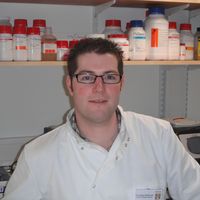Papers by Carl-otto Ottosen

EFFECTS OF LEDS ON PHOTOSYNTHESIS AND SECONDARY METABOLITES IN ROSES, CHRYSANTHEMUMS, AND CAMPANULAS
Acta Horticulturae, 2014
ABSTRACT ntegration of light emitting diodes (LEDs) in current growing systems receives full atte... more ABSTRACT ntegration of light emitting diodes (LEDs) in current growing systems receives full attention as they provide the opportunity to control light spectrum. In most cases, such research has focused on vegetables, whereas LED effects have not been extensively studied on ornamental plants. Potted Rosa hybrid ‘Scarlet’, Chrysanthemum morifolium ‘Coral Charm’, and Campanula portenschlagiana ‘BluOne’ were grown under a purpose-built LED array from Philips yielding approximately 200 µmol m-2 s-1 for 16 hours per day. The temperature in the greenhouse compartments was set to 24/18°C day/night, respectively. The four light treatments were (1) 40% Blue 60% Red, (2) 20% Blue 80% Red, (3) 100% Red, and (4) 100% White (Control). The plants were grown to flowering (except chrysanthemums) and plant growth was recorded at the end of the experiment. During the experiment photosynthetic parameters were measured and later leaf samples were analyzed by HPLC. The objective of the study was to characterize the effect of LEDs on the photosynthesis and the secondary metabolism of these plants. The leaf area was greater with increasing amount of blue light, while pure red light increased leaf area, total fresh, and total dry weight in chrysanthemums. In roses, HPLC analysis has shown that flavonoid and phenolic compounds were higher with increasing blue light ratio. In general, the differences between treatments were limited; however, in the pure red light, curled leaves and other abnormalities were observed in all species.

Sensors, 2015
To increase the understanding of how the plant phenotype is formed by genotype and environmental ... more To increase the understanding of how the plant phenotype is formed by genotype and environmental interactions, simple and robust high-throughput plant phenotyping methods should be developed and considered. This would not only broaden the application range of phenotyping in the plant research community, but also increase the ability for researchers to study plants in their natural environments. By studying plants in their natural environment in high temporal resolution, more knowledge on how multiple stresses interact in defining the plant phenotype could lead to a better understanding of the interaction between plant responses and epigenetic regulation. In the present paper, we evaluate a commercial 3D NIR-laser scanner (PlantEye, Phenospex B.V., Herleen, The Netherlands) to track daily changes in plant growth with high precision in challenging environments. Firstly, we demonstrate that the NIR laser beam of the scanner does not affect plant photosynthetic performance. Secondly, we demonstrate that it is possible to estimate phenotypic variation amongst the growth pattern of ten genotypes of Brassica napus L. (rapeseed), using a simple linear correlation between scanned parameters and destructive growth measurements. Our results demonstrate the high potential of 3D laser triangulation for simple measurements of phenotypic variation in challenging environments and in a high temporal resolution.

Screening and validation of tomato genotypes under heat stress using Fv/Fm to reveal the physiological mechanism of heat tolerance
Environmental and Experimental Botany, 2015
ABSTRACT Cultivation of tomatoes at high temperatures negatively affects growth and yield. Our ai... more ABSTRACT Cultivation of tomatoes at high temperatures negatively affects growth and yield. Our aim was to screen tomato genotypes under heat stress for differences in the maximum quantum efficiency of photosystem II (Fv/Fm) and uncover the physiological traits for heat tolerance in a three-step process. Initially, 67 tomato genotypes were ranked according to Fv/Fm. Two genotypes with higher Fv/Fm (heat-tolerant group) and two genotypes with lower Fv/Fm (heat-sensitive group) were selected from the initial screening. Second, the physiological responses of the four genotypes to seven days of heat stress (36/28 °C) were analyzed in detail. Third, pollen germination and fruit set of the four genotypes were investigated at high temperature conditions in the field. The results showed that the heat-tolerant group maintained higher leaf pigment content and higher total phenolic content (TPC) than the heat-sensitive group under heat stress. The heat-tolerant group maintained unaltered stomata and pore area and net photosynthesis rate (PN) but increased stomatal conductance (gs) under heat stress compared with the control. Chloroplasts in the heat-tolerant group maintained a normal shape, whereas the chloroplasts in the heat-sensitive group became swollen with decomposed starch grain after heat stress. The heat-tolerant group exhibited a higher pollen germination rate (%), longer pollen tube length and higher fruit set rate compared with the heat-sensitive group at high temperatures in the field. Thus, we concluded that Fv/Fm is an early indicator of heat stress tolerance and that the responses of tomatoes to heat stress were identical in widely different growing conditions. The stay-green trait, improved ability of stomata regulation and higher contents of reactive oxygen species scavengers seemed to be part of the protective mechanisms in heat-tolerant tomatoes.

Interspecific hybridization in Cucumis leads to the divergence of phenotypes in response to low light and extended photoperiods
Frontiers in Plant Science, 2015
With the aim of improving shade tolerance of cucumber, Cucumis × hytivus, a newly synthesized all... more With the aim of improving shade tolerance of cucumber, Cucumis × hytivus, a newly synthesized allotetraploid, was obtained by crossing a shade tolerant wild relative, Cucumis hystrix, with a cultivated cucumber, Cucumis sativus L. 'BejingJietou.' The results show that the new C. × hytivus only partly is an intermediate hybrid and it has not only chlorophyll deficiency, which recovers during leaf development, but also lower carotenoid content. Three light conditions with the combination of different light intensities and photoperiods were employed to investigate the photosynthetic response of these three Cucumis species to low light and long photoperiod. The consistent order of P max and DWS being lowest in C. hystrix, medium in C. × hytivus and highest in 'BejingJietou' suggests the three species to have genetically different photosynthetic efficiency, which relates well with the natural habitats of the parent species and the hybrid as intermediate. C. × hytivus appears to be inhibited by the low light levels to the same extent as the cultivated 'BeijingJietou,' which indicates neither improvement of shade tolerance nor hypothetical heterosis effect in C. × hytivus. However, unexpectedly, the PSII of C. hystrix was affected by the long photoperiod in the long term, suggested by the decrease of F v/F m. This sensitivity toward day length has not been passed on to C. × hytivus.

Log-logistic model analysis of optimal and supra-optimal temperature effect on photosystem II using chlorophyll a fluorescence in chrysanthemum (Dendranthema grandiflora)
Air temperature with modern greenhouse climate control often allows more freedom for dynamic beha... more Air temperature with modern greenhouse climate control often allows more freedom for dynamic behaviour than standard rigid greenhouse climate regimes. These types of climate control strategies potentially result in severe microclimate conditions such as high crop temperature, which affects photosynthesis and the major sensitive sites in the photosynthetic apparatus of photosystem II (PSII). In two independent experiments i) excised chrysanthemum leaves were treated with optimal and supra-optimal temperatures from 24 to 45°C and ii) intact plants were subjected to high temperature of 32/28, 38/32 and 40/36°C day/night, respectively for ten successive days. The initial fluorescence kinetics (OJIP curve) was used to characterize high temperature effect on PSII on four selected parameters. The log-logistic model of the dose response curve was used to model the maximum quantum efficiency of PSII (Fv/Fm), density of active PSII reaction centers per chlorophyll (RC/ABS), the conformation t...

Frontiers in plant science, 2015
Cultivated tomato species develop leaf injury while grown in continuous light (CL). Growth, photo... more Cultivated tomato species develop leaf injury while grown in continuous light (CL). Growth, photosynthesis, carbohydrate metabolism and antioxidative enzyme activities of a cultivated (Solanum lycopersicum L. 'Aromata') and a wild tomato species (Solanum pimpinellifolium L.) were compared in this study aiming to analyze the species-specific differences and thermoperiod effects in responses to CL. The species were subjected to three photoperiodic treatments for 12 days in climate chambers: 16-h photoperiod with a light/dark temperature of 26/16°C (P16D10 or control); CL with a constant temperature of 23°C (P24D0); CL with a variable temperature of 26/16°C (P24D10). The results showed that both species grown in CL had higher dry matter production due to the continuous photosynthesis and a subsequent increase in carbon gain. In S. lycopersicum, the rate of photosynthesis and the maximum photochemical efficiency of photosystem II declined in CL with the development of leaf chlor...

Recovery of tomato (Solanum lycopersicum L.) leaves from continuous light induced injury
Journal of plant physiology, Jan 14, 2015
Continuous light (CL) causes leaf injuries in tomato plants, but very little has been done to stu... more Continuous light (CL) causes leaf injuries in tomato plants, but very little has been done to study the nature of recovery from these leaf injuries. To facilitate this, tomato plants (Solanum lycopersicum L. cv. 'Aromata') were first exposed to CL for 11 days in order to study the development of the leaf injuries. Afterwards, the plants were exposed to a photoperiodic treatment with a dark period of eight hours to study the nature of recovery of the leaves. Plants were grown in two photoperiodic treatments in climate chambers; a control treatment with a 16/8h light/dark and a CL treatment with 24h light. The two treatments had different light intensities to maintain a similar daily light integral (15molm(-2)d(-1)). The temperature and humidity were adjusted to maintain a similar vapor pressure deficit (VPD) of 1kPa in the two treatments. After 11 days of CL, 12% of the total leaflet area appeared light green in spots on the leaf surface aligned with lower total leaf chloroph...

Daily temperature drop prevents inhibition of photosynthesis in tomato plants under continuous light
Photosynthetica, 2015
ABSTRACT The negative effects of continuous light (CL) seen in tomato plants are often claimed to... more ABSTRACT The negative effects of continuous light (CL) seen in tomato plants are often claimed to be linked to effects of offsetting the diurnal rhythm. In this study we tested whether a short-term daily temperature drop prevents the decreased photosynthetic performance seen in tomato plants grown under CL. Tomato (Lycopersicon esculentum Mill.) plantlets were grown at constant temperature of 26°C under 16-h day (16D) or 24-h day (24D) at 150 μmol m−2 s−1 PPFD. Some 24D plants were treated daily by 2 h temperature drop from 26 to 10°C (24D+DROP). Physiological disorder, such as severe leaf chlorosis, a large decrease in net photosynthetic rate, maximal quantum yield of PSII photochemistry, and the effective quantum yield of PSII photochemistry were observed in 24D, but not in 16D and 24D+DROP plants. The daily 2-h drop in temperature eliminated a negative effect of CL on photosynthesis and prevented the development of leaf chlorosis in tomato plants. This could be due to a change in carbohydrate metabolism as the short drop in temperature might have allowed some maintenance of the diurnal rhythms.

Plant physiology and biochemistry : PPB / Societe francaise de physiologie vegetale, Jan 26, 2015
Under a dynamic greenhouse climate control regime, temperature is adjusted to optimise plant phys... more Under a dynamic greenhouse climate control regime, temperature is adjusted to optimise plant physiological responses to prevailing irradiance levels; thus, both temperature and irradiance are used by the plant to maximise the rate of photosynthesis, assuming other factors are not limiting. The control regime may be optimised by monitoring plant responses, and may be promptly adjusted when plant performance is affected by extreme microclimatic conditions, such as high irradiance or temperature. To determine the stress indicators of plants based on their physiological responses, net photosynthesis (Pn) and four chlorophyll-a fluorescence parameters: maximum photochemical efficiency of PSII [Fv/Fm], electron transport rate [ETR], PSII operating efficiency [F'q/F'm], and non-photochemical quenching [NPQ] were assessed for potted chrysanthemum (Dendranthema grandiflora Tzvelev) 'Coral Charm' under different temperature (20, 24, 28, 32, 36 °C) and daily light integrals (DL...

Foliar abscisic acid content underlies genotypic variation in stomatal responsiveness after growth at high relative air humidity
Annals of botany, 2013
Stomata formed at high relative air humidity (RH) respond less to abscisic acid (ABA), an effect ... more Stomata formed at high relative air humidity (RH) respond less to abscisic acid (ABA), an effect that varies widely between cultivars. This study tested the hypotheses that this genotypic variation in stomatal responsiveness originates from differential impairment in intermediates of the ABA signalling pathway during closure and differences in leaf ABA concentration during growth. Stomatal anatomical features and stomatal responsiveness to desiccation, feeding with ABA, three transduction elements of its signalling pathway (H2O2, NO, Ca(2+)) and elicitors of these elements were determined in four rose cultivars grown at moderate (60 %) and high (90 %) RH. Leaf ABA concentration was assessed throughout the photoperiod and following mild desiccation (10 % leaf weight loss). Stomatal responsiveness to desiccation and ABA feeding was little affected by high RH in two cultivars, whereas it was considerably attenuated in two other cultivars (thus termed sensitive). Leaf ABA concentration ...

Frontiers in Plant Science, 2015
To evaluate the effect of blue light intensity and timing, two cultivars of lettuce [Lactuca sati... more To evaluate the effect of blue light intensity and timing, two cultivars of lettuce [Lactuca sativa cv. "Batavia" (green) and cv. "Lollo Rossa" (red)] were grown in a greenhouse compartment in late winter under natural light and supplemental high pressure sodium (SON-T) lamps yielding 90 (±10) μmol m −2 s −1 for up to 20 h, but never between 17:00 and 21:00. The temperature in the greenhouse compartments was 22/11 • C day/night, respectively. The five light-emitting diode (LED) light treatments were Control (no blue addition), 1B 06-08 (Blue light at 45 μmol m −2 s −1 from 06:00 to 08:00), 1B 21-08 (Blue light at 45 μmol m −2 s −1 from 21:00 to 08:00), 2B 17-19 (Blue at 80 μmol m −2 s −1 from 17:00 to 19:00), and 1B 17-19 (Blue at 45 μmol m −2 s −1 from 17:00 to 19:00). Total fresh and dry weight was not affected with additional blue light; however, plants treated with additional blue light were more compact. The stomatal conductance in the green lettuce cultivar was higher for all treatments with blue light compared to the Control. Photosynthetic yields measured with chlorophyll fluorescence showed different response between the cultivars; in red lettuce, the quantum yield of PSII decreased and the yield of non-photochemical quenching increased with increasing blue light, whereas in green lettuce no difference was observed. Quantification of secondary metabolites showed that all four treatments with additional blue light had higher amount of pigments, phenolic acids, and flavonoids compared to the Control. The effect was more prominent in red lettuce, highlighting that the results vary among treatments and compounds. Our results indicate that not only high light level triggers photoprotective heat dissipation in the plant, but also the specific spectral composition of the light itself at low intensities. However, these plant responses to light are cultivar dependent.

Journal of Experimental Botany, 2014
Leaf abscisic acid concentration ([ABA]) during growth influences morpho-physiological traits ass... more Leaf abscisic acid concentration ([ABA]) during growth influences morpho-physiological traits associated with the plant's ability to cope with stress. A dose-response curve between [ABA] during growth and the leaf's ability to regulate water loss during desiccation or rehydrate upon re-watering was obtained. Rosa hybrida plants were grown at two relative air humidities (RHs, 60% or 90%) under different soil water potentials (-0.01, -0.06, or -0.08 MPa) or upon grafting onto the rootstock of a cultivar sustaining [ABA] at elevated RH. Measurements included [ABA], stomatal anatomical features, stomatal responsiveness to desiccation, and the ability of leaves, desiccated to varying degrees, to recover their weight (rehydrate) following re-watering. Transpiration efficiency (plant mass per transpired water) was also determined. Soil water deficit resulted in a lower transpiration rate and higher transpiration efficiency at both RHs. The lowest [ABA] was observed in well-watered plants grown at high RH.
Journal of Plant Physiology, 2015
journal h om epage: www.elsevier.com/locate/jplph Corrigendum Corrigendum to "Spectral effects of... more journal h om epage: www.elsevier.com/locate/jplph Corrigendum Corrigendum to "Spectral effects of supplementary lighting on the secondary metabolites in roses, chrysanthemums, and campanulas" [The authors regret that in Fig. 2 the unit for P n is mmol m −2 s −1 . The correct should be mol m −2 s −1 . The same applies for Fig. 3 in the legend, where it says "and the bar graphs show g s at 200 mmol m −2 s −1 ". This should also read 200 mol m −2 s −1 .The authors would like to apologise for any inconvenience caused. DOI of original article: http://dx.

Wheat cultivars selected for high F v /F m under heat stress maintain high photosynthesis, total chlorophyll, stomatal conductance, transpiration and dry matter
Physiologia Plantarum, 2014
The chlorophyll fluorescence parameter Fv /Fm reflects the maximum quantum efficiency of photosys... more The chlorophyll fluorescence parameter Fv /Fm reflects the maximum quantum efficiency of photosystem II (PSII) photochemistry and has been widely used for early stress detection in plants. Previously, we have used a three-tiered approach of phenotyping by Fv /Fm to identify naturally existing genetic variation for tolerance to severe heat stress (3 days at 40°C in controlled conditions) in wheat (Triticum aestivum L.). Here we investigated the performance of the previously selected cultivars (high and low group based on Fv /Fm value) in terms of growth and photosynthetic traits under moderate heat stress (1 week at 36/30°C day/night temperature in greenhouse) closer to natural heat waves in North-Western Europe. Dry matter accumulation after 7 days of heat stress was positively correlated to Fv /Fm . The high Fv /Fm group maintained significantly higher total chlorophyll and net photosynthetic rate (PN ) than the low group, accompanied by higher stomatal conductance (gs ), transpiration rate (E) and evaporative cooling of the leaf (ΔT). The difference in PN between the groups was not caused by differences in PSII capacity or gs as the variation in Fv /Fm and intracellular CO2 (Ci ) was non-significant under the given heat stress. This study validated that our three-tiered approach of phenotyping by Fv /Fm performed under increasing severity of heat was successful in identifying wheat cultivars differing in photosynthesis under moderate and agronomically more relevant heat stress. The identified cultivars may serve as a valuable resource for further studies to understand the physiological mechanisms underlying the genetic variability in heat sensitivity of photosynthesis.

Spectral effects of LEDs on chlorophyll fluorescence and pigmentation in Phalaenopsis ‘Vivien’ and ‘Purple Star’
Physiologia Plantarum, 2014
We examined the effect of light emitting diode (LED) lighting in greenhouse facilities on growth,... more We examined the effect of light emitting diode (LED) lighting in greenhouse facilities on growth, chlorophyll fluorescence and pigmentation in Phalaenopsis 'Vivien' and 'Purple Star' under purpose-built LED arrays yielding c. 200 µmol m(-2) s(-1) at plant height for 14 h per day and 24/18°C day/night temperature, respectively, from January to April 2013. The light treatments were (1) 40% blue in 60% red (40% B/R), (2) 0% blue in 100% red (0% B/R) and (3) white LEDs with 32% blue in white (32% B/W, control), with background daylight under shade screens. The plants were harvested twice for leaf growth and pigmentation. There was no clear pattern in the spectral effect on growth since the order of leaf size differed between harvests in March and April. Fv /Fm was in the range of 0.52-0.72, but overall slightly higher in the control, which indicated a permanent downregulation of PSII in the colored treatments. The fluorescence quenching showed no acclimation to color in 'Purple Star', while 'Vivien' had lower ETR and higher NPQ in the 40% B/R, resembling low light acclimation. The pigmentation showed corresponding spectral response with increasing concentration of lutein while increasing the fraction of blue light, which increased the light absorption in the green/yellow part of the spectrum. The permanent downregulation of PSII moved a substantial part of the thermal dissipation from the light regulated NPQ to non-regulated energy losses estimated by ΦNPQ and ΦNO and the difference found in the balance between ΦPSII and ΦNPQ in 'Vivien' disappeared when ΦNO was included in the thermal dissipation.

Spectral effects of supplementary lighting on the secondary metabolites in roses, chrysanthemums, and campanulas
Journal of Plant Physiology, 2014
To investigate the effect of the light spectrum on photosynthesis, growth, and secondary metaboli... more To investigate the effect of the light spectrum on photosynthesis, growth, and secondary metabolites Rosa hybrida 'Scarlet', Chrysanthemum morifolium 'Coral Charm', and Campanula portenschlagiana 'BluOne' were grown at 24/18°C day/night temperature under purpose-built LED arrays yielding approximately 200 μmol m(-2)s(-1) at plant height for 16 h per day. The four light treatments were (1) 40% Blue/60% Red, (2) 20% Blue/80% Red, (3) 100% Red, and (4) 100% White (Control). The plant height was smallest in 40% Blue/60% Red in roses and chrysanthemums, while the biomass was smallest in the white control in roses and in 100% Red in chrysanthemums. The total biomass was unaffected by the spectrum in campanulas, while the leaf area was smallest in the 40% Blue/60% Red treatment. In 100% Red curled leaves and other morphological abnormalities were observed. Increasing the blue to red ratio increased the stomatal conductance though net photosynthesis was unaffected, indicating excess stomatal conductance in some treatments. With higher blue light ratio all phenolic acids and flavonoids increased. In view of the roles of these secondary metabolites as antioxidants, anti-pathogens, and light protectants, we hypothesize that blue light may predispose plants to better cope with stress.

Pore size regulates operating stomatal conductance, while stomatal densities drive the partitioning of conductance between leaf sides
Annals of botany, Jan 22, 2014
Leaf gas exchange is influenced by stomatal size, density, distribution between the leaf adaxial ... more Leaf gas exchange is influenced by stomatal size, density, distribution between the leaf adaxial and abaxial sides, as well as by pore dimensions. This study aims to quantify which of these traits mainly underlie genetic differences in operating stomatal conductance (gs) and addresses possible links between anatomical traits and regulation of pore width. Stomatal responsiveness to desiccation, gs-related anatomical traits of each leaf side and estimated gs (based on these traits) were determined for 54 introgression lines (ILs) generated by introgressing segments of Solanum pennelli into the S. lycopersicum 'M82'. A quantitative trait locus (QTL) analysis for stomatal traits was also performed. A wide genetic variation in stomatal responsiveness to desiccation was observed, a large part of which was explained by stomatal length. Operating gs ranged over a factor of five between ILs. The pore area per stomatal area varied 8-fold among ILs (2-16 %), and was the main determinan...

Plant Physiology and Biochemistry, 2013
Modern highly insulated greenhouses are more energy efficient than conventional types. Furthermor... more Modern highly insulated greenhouses are more energy efficient than conventional types. Furthermore applying dynamic greenhouse climate control regimes will increase energy efficiency relatively more in modern structures. However, this combination may result in higher air and crop temperatures. Too high temperature affects the plant photosynthetic responses, resulting in a lower rate of photosynthesis. To predict and analyse physiological responses as stress indicators, two independent experiments were conducted, to detect the effect of high temperature on photosynthesis: analysing photosystem II (PSII) and stomatal conductance (g s ). A combination of chlorophyll a fluorescence, gas exchange measurements and infrared thermography was applied using Chrysanthemum (Dendranthema grandiflora Tzvelev) 'Coral Charm' as a model species. Increasing temperature had a highly significant effect on PSII when the temperature exceeded 38 C for a period of 7 (AE1.8) days. High temperature decreased the maximum photochemical efficiency of PSII (F v /F m ), the conformation term for primary photochemistry (F v /F o ) and performance index (PI), as well as increased minimal fluorescence (F o ). However, at elevated CO 2 of 1000 mmol mol À1 and with a photosynthetic photon flux density (PPFD) of 800 mmol m À2 s À1 , net photosynthesis (P n ) reached its maximum at 35 C. The thermal index (I G ), calculated from the leaf temperature and the temperature of a dry and wet reference leaf, showed a strong correlation with g s . We conclude that 1) chlorophyll a fluorescence and a combination of fluorescence parameters can be used as early stress indicators as well as to detect the temperature limit of PSII damage, and 2) the strong relation between g s and I G enables g s to be estimated non-invasively, which is an important first step in modelling leaf temperature to predict unfavourable growing conditions in a (dynamic) semi closed greenhouse.











Uploads
Papers by Carl-otto Ottosen